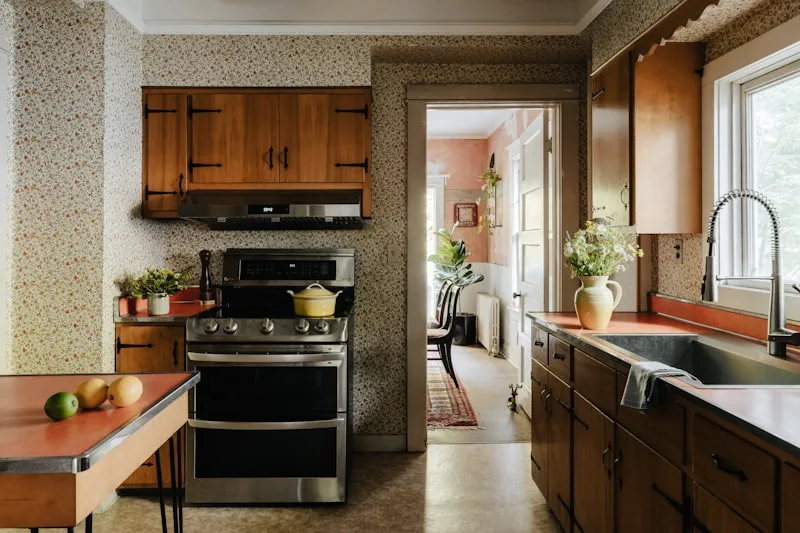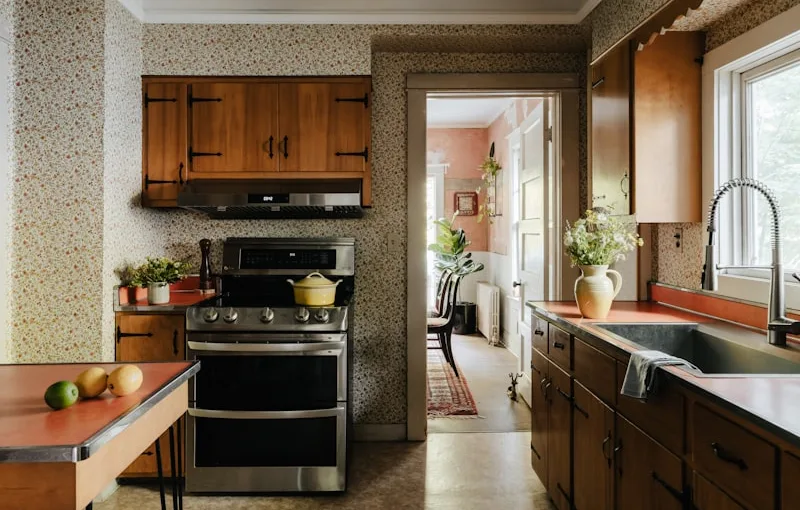Typically, upper cabinets are installed about 18 inches above the countertop. This height allows for easy access while cooking and prepping meals. But wait, there’s more! If you’re on the taller side, you might want to raise those cabinets a bit higher—think 20 to 24 inches above the counter. It’s all about comfort and convenience. Imagine reaching for that spice jar on the top shelf; you don’t want to feel like you’re scaling a mountain every time you cook!
Another factor to consider is the ceiling height. If you’ve got lofty ceilings, you can take advantage of that space by installing cabinets that stretch closer to the ceiling. Not only does this create a more cohesive look, but it also gives you extra storage for those items you rarely use. It’s like finding hidden treasure in your own home!
And let’s not forget about aesthetics. The height of your upper cabinets can dramatically affect the overall vibe of your kitchen. Lower cabinets can make a space feel cozy and intimate, while higher cabinets can create an airy, open feel. So, when deciding how high to go, think about the atmosphere you want to create.
Reaching New Heights: The Ultimate Guide to Upper Kitchen Cabinet Placement
First off, think about your ceiling height. If you’ve got soaring ceilings, why not take advantage of that vertical space? Placing your upper cabinets closer to the ceiling not only draws the eye upward, making the room feel larger, but it also gives you extra storage for those items you rarely use. Just picture those holiday platters tucked away, waiting for their moment to shine!
Now, let’s talk about the golden rule: the 18-inch gap between the countertop and the bottom of your upper cabinets. This sweet spot allows for ample workspace while keeping everything within arm’s reach. It’s like having your cake and eating it too—functionality meets aesthetics!
But what about the style? Consider the layout of your kitchen. If you have an island, you might want to align your upper cabinets with it for a cohesive look. Think of it as creating a visual rhythm in your space. And don’t shy away from mixing materials! A wood finish on the upper cabinets can beautifully contrast with sleek, modern lower cabinets, adding depth and character.
Cabinet Conundrum: Finding the Perfect Height for Your Kitchen Storage
First off, let’s talk about the average height. Most kitchen cabinets sit around 30 inches off the ground, which is great for standard countertops. But what if you’re taller or shorter than average? It’s like wearing shoes that don’t fit—uncomfortable and impractical. If you’re on the taller side, consider raising those cabinets a few inches. This way, you won’t have to bend down every time you want to grab a pot or pan. On the flip side, if you’re more petite, lowering the cabinets can make all the difference. You want to be able to access your kitchen essentials without a ladder!
Now, think about your lifestyle. Do you love cooking and need easy access to your spices and utensils? Or are you more of a microwave chef who rarely opens the cabinets? Tailoring the height to your cooking habits can transform your kitchen experience. It’s like customizing a car to fit your driving style—suddenly, everything feels smoother and more enjoyable.
Above the Counter: How to Determine the Ideal Height for Upper Kitchen Cabinets
First off, consider your own height. If you’re on the taller side, you might want those cabinets a bit higher to avoid the dreaded head bump. Conversely, if you’re more vertically challenged, you’ll want them lower for easy access. A good rule of thumb is to install them about 18 inches above the countertop. This gives you enough space to work without feeling like you’re in a game of kitchen limbo.
Next, think about the overall design of your kitchen. Are you going for a sleek, modern look or a cozy, rustic vibe? The height of your cabinets can influence that aesthetic. For instance, if you have high ceilings, extending your cabinets all the way up can create a stunning visual effect, almost like a grand library of culinary delights. It’s like giving your kitchen a crown!
Also, don’t forget about functionality. If you’re a cooking enthusiast, you might want to keep your most-used items within arm’s reach. Consider incorporating open shelving or glass-front cabinets at a lower height for easy access to your favorite dishes. It’s like having a personal showcase for your kitchen treasures!
Lastly, think about lighting. Installing cabinets too high can cast shadows on your workspace, making it feel cramped. Aim for a height that allows for ample light to flood your countertops, creating a warm and inviting atmosphere. After all, a well-lit kitchen is a happy kitchen!
The Science of Cabinetry: What’s the Best Height for Upper Kitchen Cabinets?
Typically, upper cabinets are installed 18 to 24 inches above the countertop. This range allows for comfortable access while keeping your kitchen looking sleek and organized. But here’s where it gets interesting: the ideal height can vary based on your personal height and the overall design of your kitchen. If you’re on the taller side, you might want to push those cabinets a bit higher, while shorter folks might prefer them lower for easy access.
Think of your kitchen as a well-orchestrated symphony. Each element, including cabinet height, plays a crucial role in the harmony of the space. If your cabinets are too high, they can create a sense of disconnection, making the kitchen feel less inviting. On the flip side, if they’re too low, you might feel cramped, like you’re in a dollhouse.
Also, consider the ceiling height. In a standard 8-foot kitchen, those 18 to 24 inches above the counter usually work perfectly. But if you’ve got soaring ceilings, you might want to take advantage of that vertical space. Installing cabinets closer to the ceiling can draw the eye upward, making the room feel larger and more open.
Design Dilemma: How High Should Your Upper Kitchen Cabinets Really Be?
First off, let’s talk about the average height. Most upper cabinets sit around 18 inches above the countertop, but that’s just a guideline. If you’re on the taller side, you might want to raise them a bit higher to avoid that awkward bending. Think of it like adjusting the height of a basketball hoop—if it’s too low, you’ll never get a slam dunk!
Now, consider your ceiling height. If you’ve got lofty ceilings, you might be tempted to stack those cabinets all the way to the top. But hold on! While it can look stunning, it can also make it a pain to access your dishes. Imagine reaching for that fancy china you only use once a year—yikes!
Another factor to think about is the overall style of your kitchen. If you’re going for a modern vibe, higher cabinets can create a sleek, streamlined look. On the flip side, if you’re into a cozy, farmhouse feel, lower cabinets might be the way to go, giving you that warm, inviting atmosphere.
And let’s not forget about functionality. If you’re a cooking enthusiast, having your essentials within easy reach is crucial. So, ask yourself: how often do you use those items? If they’re daily staples, keep them lower. If they’re just for show, go ahead and elevate them.
Ultimately, the height of your upper kitchen cabinets should reflect your lifestyle, taste, and the space you’re working with. It’s all about finding that perfect balance!
Maximizing Space: Tips for Choosing the Right Height for Upper Kitchen Cabinets
First off, think about your own height and reach. If you’re on the shorter side, you don’t want to be stretching like a cat trying to catch a laser pointer just to grab a spice jar. Ideally, the bottom of your upper cabinets should be around 18 inches above the countertop. This height not only gives you easy access but also creates a comfortable flow in the kitchen.
Now, let’s talk about the ceiling. If you have high ceilings, consider extending those cabinets all the way up. It’s like giving your kitchen a crown! Not only does it create a seamless look, but it also provides extra storage for items you don’t use every day, like holiday platters or that fancy punch bowl.
But what if your kitchen is on the smaller side? No worries! You can still maximize space by opting for open shelving above the counters. This not only makes the room feel more open but also allows you to display your favorite dishes or cookbooks, adding a personal touch.
And don’t forget about lighting! Installing under-cabinet lighting can illuminate your workspace, making it feel larger and more inviting. It’s like adding a spotlight to your culinary stage.
So, whether you’re reaching for that elusive can of beans or showcasing your prized collection of mugs, the right height for your upper kitchen cabinets can transform your cooking space into a functional and stylish haven.
From Floor to Ceiling: The Art of Upper Kitchen Cabinet Height Selection

So, how do you determine that sweet spot? First off, consider your ceiling height. If you’ve got lofty ceilings, you might be tempted to stretch those cabinets all the way up. But hold on! While it can create a stunning visual effect, it can also make it a hassle to access your favorite dishes. Think of it like a high shelf in a grocery store—sure, it looks great, but good luck reaching that box of cereal!
Next, let’s talk about your own height. If you’re on the shorter side, you might want to keep those cabinets lower to avoid the dreaded tiptoe dance every time you need a spice jar. On the flip side, if you’re tall, you can afford to go a bit higher, but don’t forget about your guests. You want everyone to feel at home in your kitchen, right?
Frequently Asked Questions
Can I Customize the Height of My Kitchen Cabinets?
Yes, kitchen cabinets can be customized to different heights to suit your needs and preferences. This allows for better functionality and aesthetics in your kitchen space. Consult with a professional to determine the best height for your cabinets based on your kitchen layout and personal requirements.
Should Upper Cabinets Be Installed Above the Countertop?
Installing upper cabinets above the countertop is essential for maximizing kitchen storage and functionality. This placement allows for easy access to frequently used items while keeping the countertop clear for food preparation and other tasks. Proper height ensures that the cabinets are within reach and do not obstruct sightlines, enhancing both usability and aesthetics.
What is the Standard Height for Upper Kitchen Cabinets?
The standard height for upper kitchen cabinets is typically 18 inches above the countertop, resulting in a total height of around 54 to 60 inches from the floor. This height allows for comfortable access to items while maximizing storage space.
How Do I Determine the Right Height for My Kitchen Cabinets?
To determine the appropriate height for kitchen cabinets, consider the standard counter height of 36 inches and the average reach of users. Wall cabinets are typically installed 18 inches above the countertop, while the bottom of upper cabinets should be around 54 inches from the floor for optimal accessibility. Adjustments may be necessary based on individual height and preferences.
What Factors Influence Upper Cabinet Height?
The height of upper cabinets is influenced by several factors including ceiling height, the height of the users, the intended use of the cabinets, and design preferences. Standard heights typically range from 18 to 24 inches above the countertop, but adjustments may be made for accessibility and aesthetics. Consideration of these factors ensures functionality and comfort in kitchen design.
